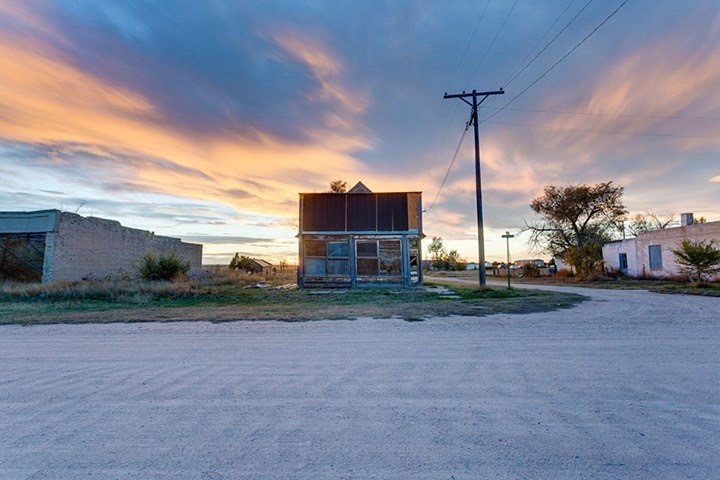Year Listed: 2017
County: Weld County
Construction Date: 1900s
Threat When Listed: Demolition by Neglect
Status: IN PROGRESS
Video courtesy of CBS4
“New Raymer was and still is a true representation of what epitomized rural life in Colorado. We would love to see the buildings that still remain in the community cared for and held up as living history.” ~ Talia Siens Agricultural communities have formed the backbone of Colorado’s Eastern Plains since the late-1880s. The towns and cities have endured droughts, harsh winters, relentless winds, population changes and economic depressions. But the one thing that has remained constant is the strength of the communities and the perseverance of the people. The town of New Raymer anchored by its Main Street, Centre Avenue, is no different.
Agricultural communities have formed the backbone of Colorado’s Eastern Plains since the late-1880s. The towns and cities have endured droughts, harsh winters, relentless winds, population changes and economic depressions. But the one thing that has remained constant is the strength of the communities and the perseverance of the people. The town of New Raymer anchored by its Main Street, Centre Avenue, is no different.
 The Town of Raymer was established in 1888 along a new line of the Colorado and Wyoming Railroad Company running from Sterling to Cheyenne. Homesteaders from eastern Nebraska settled the town in the 1880s, drawn to the area by claims of fertile, lush land ripe for cultivation. Unfortunately, this was a far cry from the actual conditions of the arid grasslands. The feasibility of an agricultural economy improved with the passage of the Enlarged Homestead Act in 1909, which provided larger homestead tracts for farming. This again drew people to the area and in 1910 the townsite was platted and recorded as the Town of Raymer. Before the days of zip codes, the post office changed Raymer to New Raymer to avoid confusion with Ramah, Colorado.
The Town of Raymer was established in 1888 along a new line of the Colorado and Wyoming Railroad Company running from Sterling to Cheyenne. Homesteaders from eastern Nebraska settled the town in the 1880s, drawn to the area by claims of fertile, lush land ripe for cultivation. Unfortunately, this was a far cry from the actual conditions of the arid grasslands. The feasibility of an agricultural economy improved with the passage of the Enlarged Homestead Act in 1909, which provided larger homestead tracts for farming. This again drew people to the area and in 1910 the townsite was platted and recorded as the Town of Raymer. Before the days of zip codes, the post office changed Raymer to New Raymer to avoid confusion with Ramah, Colorado.
Development followed immediately thereafter, when W.M. Truxaw purchased the first lot along Centre Avenue on the same day it was platted. He constructed the Truxaw and Krueger Grocery building, which would later become the post office. Stores, shops, hotels and businesses soon followed, creating a thriving downtown core along Centre Avenue. Newspaper advertisements show that a variety of businesses served the town in the 1910s and 1920s, including hardware stores, liveries, stables and bakeries, hotels, drug stores, a tractor dealership, gas stations, and a bank.
The town population declined in the 1930s due to drought and economic depression. This decline continued into the next decades, and by the 1960s most of the businesses along Centre Avenue had closed. Despite these changes, New Raymer remained a gathering place for the surrounding population. Descendants of the early pioneers that settled New Raymer still reside in the nearby rural areas. They continue to farm and ranch in the area, and come to town to meet for church, school and social activities. Many of the families have known one another for generations, and the community hopes to keep these stories and relationships alive by revitalizing the downtown core.
The majority of the buildings along Centre Avenue have changed little since first constructed in the 1910s and 1920s. The town is emblematic of the many small agricultural market centers that once thrived throughout the plains region of northeastern Colorado. Colorado Preservation, Inc. believes restoration of the Post Office building can serve as a catalyst for downtown and serve as an example for similar communities.
| “We have two grandsons who are 5th generation New Raymer. For them to be able to see where their grandparents and great-grandparents and great-great-grandmother (all still living) once hung out, would be like out of a story book.” ~ Anne Canvasser |
A preliminary Determination of Eligibility was completed but a National Register District was not recommended. Instead 3 or 4 key properties were determined eligible for individual listing on the state or national register and will be the initial focus of the project. Currently, The Mercantile Building is nominated to the state historic register. These efforts are being driven by The Friends of New Raymer, a 501 (c)(3) non-profit organization formed in 2017.
In recent years, the Kruger/Truxall Grocery has been added to the State Register of Historic Properties and the Star Texaco has been added to the National Register of Historic Places. CPI completed mothballing at the Texaco station in the fall of 2020. Funding has also been secured for a proposed branch library in the Truxall Mercantile building, where a new $50,000 SHF grant was awarded for its stabilization.

“It is so important to many of us still living in this small community that the history of the area and the town be preserved for children, grandchildren and great-grandchildren. If this does not happen, all of the history, memories, hard work, perseverance of the residents of this area will be lost.” ~ Carol Lambert






